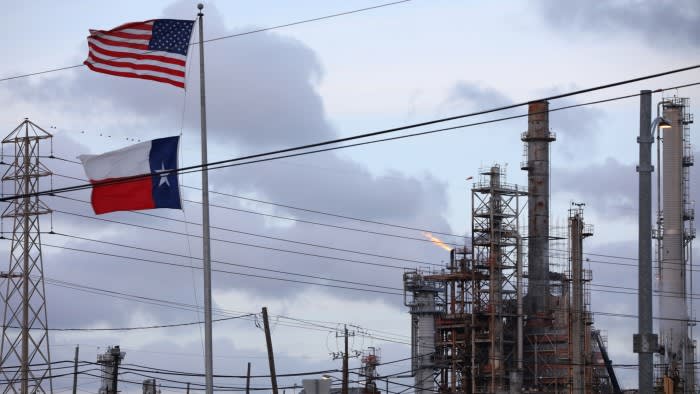Thousands of international companies will still face pressure to meet the higher bar for climate risk information set by Europe, despite the wider gap in global standards created by the new lighter rules of the US Securities and Exchange Commission.
“American corporations that want to operate in Europe are going to have to abide by regulations around disclosure and reporting that they have been fiercely lobbying against in the US,” said Mark Campanale, founder of the Carbon Tracker think-tank.
These companies will have to decide whether trading in the EU is worth the extra regulatory burden, he said. “You could end up having the most amazing regulatory regime in Europe around climate and carbon but losing your industrial base, listings or capital to the US; regulatory arbitrage is to be feared.”
The US securities regulator last week enacted a rule that will require basic company disclosures on climate risks but could leave big polluters free to keep their entire carbon footprint and other risk factors under wraps.
While the US under the administration of President Joe Biden has offered the carrot of $370bn of incentives to boost green initiatives over the next decade, the EU has been pushing companies to give investors all the information they need to factor climate risk into their decision-making.
Under the most far-reaching climate data rules in the world, from next year the EU will expect large and listed companies to publish their carbon footprint from direct operations and energy usage, as well as their contribution to both suppliers’ and customers’ emissions, under the corporate sustainability reporting directive (CSRD).
For example, under these rules, an oil refiner and a car salesroom would share the emissions from the combustion engine of their ultimate client driving to work.
At least 10,300 companies outside the EU will eventually be caught by these rules, including more than 3,000 American companies, according to analysis by Refinitiv, part of the London Stock Exchange Group.

It is not only the EU rules that could catch multinationals.
US companies such as Chevron and Amazon will also fall under rules imposed by California, which are less extensive than the EU but do require carbon footprint disclosures.
Beyond those jurisdictions are more than a dozen other countries, including the UK, Japan, New Zealand, Hong Kong and Singapore, which have all indicated that they plan to align with a set of extensive disclosure requirements released by the most prominent voluntary initiatives.
These include the International Sustainability Standards Board and its precursor, the Task Force on Climate-related Financial Disclosures. The ISSB operates under the globally accepted International Finance Reporting Standards, responsible for accounting standards.
“[The SEC] just ignored the need to harmonise globally and . . . that’s a nightmare for issuers,” said Allison Herren Lee, a lawyer at Kohn, Kohn & Colapinto and a former SEC commissioner.
The Brussels influence
Unlike most other jurisdictions, Brussels has made it clear that it considers the risks a company creates for the planet just as relevant for investors as the risks the company faces from climate change.
This means companies caught by its CSRD must detail the impact of their operations on the environment and people, from pesticides to pollution and human rights issues, on top of information about their carbon footprint, climate targets and risks.
Fearing this burden, some companies have recently withdrawn their listing from stock exchanges in EU bloc countries to sidestep the tough requirements that will take effect for next year’s set of reports, said Raza Naeem, a partner focused on financial regulation at international law firm Linklaters.
Climate disclosures and red tape linked to the green agenda have also raised concerns about the competitiveness of EU industry inside the bloc.
“US companies in [the EU’s] scope will have to comply with the highest standard,” he said. “Some companies delist to avoid it becoming an issue.”
Others are actively considering delisting, Naeem warned, because of uncertainty around supplemental guidelines on rules for non-EU companies, which are due to be adopted by Brussels in 2026.
Reporting multiple times under US, EU and other regimes will be “obviously inefficient and costly for companies to do, said Mark Vaessen, KPMG’s global head of corporate and sustainability reporting.
But this must be weighed up against the risk of being overlooked by big investors who become concerned that the lighter information provided under SEC rules does not give them enough to judge climate risks, he added.
“By definition it’s a somewhat higher risk for you as an investor [if you are missing information]. It’s clear that investors do want this information on the climate-related business and opportunities.”
Carbon accounting
For companies, getting a grip on indirect emissions, which make up the majority of most climate footprints, is one of the biggest challenges that arise from navigating fragmented disclosure standards.
These are considered hard to account for because of a vicious global cycle whereby companies cannot report on their own carbon footprint fully, without resorting to estimates, before their customers or suppliers do so consistently.
The SEC said it had excluded disclosures of scope 3 emissions, the broader measurement that includes products a company buys from third parties, from the final rule partly because of compliance costs.
For the UK software developer Aveva, which is owned by the French multinational Schneider Electric and has a significant presence in the US, most scope 3 indirect carbon emissions stem from the fossil fuels burnt to power its clients’ use of its software.
The snag is that not all of its clients share these emissions from power usage with investors or directly with Aveva.
Estimating them is complex. Its modelling suggests that software that must be run full time — for example by pharmaceutical companies to keep vaccine batches at controlled temperatures — can be more emissions-intensive than programs used for a few hours a day by big energy companies. “We’re still in the estimate phase,” said Lisa Wee, its global head of sustainability.
Climate risk statements
For investors, climate-focused risk assessments in financial reports can be more useful than unaudited sustainability data that shows carbon emissions, said Natasha Landell-Mills, head of stewardship at asset manager Sarasin & Partners.
“In the end, what [investors] need to worry about is how climate risks impact economic growth and company performance,” she said. “People are getting their heads round the fact climate change is financial; people still see this as an environmental issue and not an economic one.”
Carbon Tracker found this year that just 34 per cent out of 140 of the world’s most-polluting companies included some information in financial statements about how they manage climate-related financial risk. US-based companies were less likely to report along these lines.
Unlike many of its US counterparts, UK-headquartered Shell, for example, disclosed risk from a scenario under which the world reaches net zero emissions by 2050 in its financial statements last year. Shell priced this risk to upstream and integrated assets at between $17bn and $23bn.
The IFRS and similar standard-setting organisations have recently clarified that climate risk could be considered “material” information for investors even when accounting standards do not specifically ask for climate-related disclosures.
The new SEC requirements for information in audited financial statements are mostly limited to costs incurred from extreme weather events, as opposed to information on climate risk and emissions reported without the same standards of verification.
This contrasts with the position of the European Securities and Markets Authority, the securities regulator, which has repeatedly told companies and auditors that climate risk should be considered throughout financial statements.
“Imagine drug labels without any side effects listed,” said Mike Litt, consumer campaigns director at the Public Interest Research Group in the US, welcoming the SEC’s move to make at least some climate disclosures mandatory. “That’s kind of what it’s been like [until now] for investors trying to assess climate-related financial risks to their retirement savings.”
Boardroom cheat sheet: what to disclose and when

2025
-
Large and listed EU-based companies to start reporting under corporate sustainability reporting directive. Also applies to large EU subsidiaries of foreign companies, with debt or equity listed on EU markets.
2026
-
Under new SEC rules, the largest companies registered with the US regulator to start reporting costs relating to severe weather events, as well as the use of carbon credits and renewable energy certificates, in audited financial statements.
-
Report climate-related risks related to their direct operations (scope 1 and 2), how directors manage the risks, plus corporate climate targets.
-
Companies that do business in California with more than $500mn in annual revenue to provide information about climate-related financial risks and the operational carbon footprint (scope 1 and 2) by January 1. Those with more than $1bn in revenue also start disclosing their direct emissions and those from their own energy usage.
-
Large EU subsidiaries of non-EU companies to start reporting under Brussels’ CSRD, as well as some smaller EU companies.
-
Listed companies in Singapore to start reporting climate-related disclosures.
2027
-
Large SEC-registered companies to start reporting greenhouse gas emissions from their own operations and energy use where they deem it “material” information for investors, with some smaller companies following suit in 2029.
-
Smaller SEC-registered companies to start disclosing climate-related risks in 2027 and 2028.
-
Larger businesses with a presence in California to start disclosing scope 3 carbon emissions, those linked to suppliers and customers.
2029
-
Non-EU companies with an EU subsidiary or branch with at least €150mn in net revenue and that meet certain other tests to start reporting under CSRD at parent company level, under guidelines still being developed.
Additional reporting by Aime Williams, Stefania Palma and Alice Hancock
Climate Capital

Where climate change meets business, markets and politics. Explore the FT’s coverage here.
Are you curious about the FT’s environmental sustainability commitments? Find out more about our science-based targets here
Also Read More: World News | Entertainment News | Celebrity News








